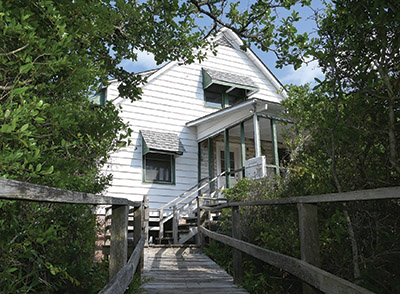Pawleys Island
Town’s ‘50 percent rule’ seen as incentive for teardowns

Any homeowner will tell you the cost of renovations adds up fast. But in the town of Pawleys Island, those numbers also count down until they reach 50 percent of a home’s fair market value. At that point, the owner must bring the property into compliance with all the town’s regulations.
“Right now it’s a 50-50 shot: Are you going to renovate that kind of cool looking house or are you going to renovate with a trackhoe and a Dumpster,” said Dan Stacy, an island property owner and attorney who has represented clients before the town’s Board of Zoning Appeals.
For the last 18 months, the town has been looking at ways to ensure that nine houses listed on the National Register of Historic Places are preserved. That followed the creation of architectural guidelines in 2021 that require new homes to include elements of the “Pawleys look.”
In between the very old and the very new are houses from the 20th century that existed before the town was created in 1985. While they may have the character owners want, they don’t have the amenities. “We’re talking about most of these homes that have setback violations or other types of violations, but they were compliant when they were built,” said Stacy, who owns a house on the north end that was built in 1906, burned in 1948 and renovated in 2014.
This spring, he helped the owners of Liberty Lodge, a National Register property, get approval to tear down a 1940s house, Port Arthur, on the same lot to build a new house. That was conditioned on preserving the exterior of the 19th century Liberty Lodge in perpetuity.
Stacy told the town Planning Commission this month that he is seeing increasing conflict between the so-called 50-percent rule and the town’s goals of historic preservation.
“It is more of an incentive to tell that older-structure owner to tear it down and just start over,” he said. “You just have scores – if not a couple of hundred structures – that are not compliant.”
Commission member Ed Fox understands the problem. He said he watched people renovate houses around his on the north end before the 50-percent rule was adopted. When he decided to expand his house, it was too late.
“I didn’t want to tear my house down, I wanted to add to it. An architect looked at it – we spent a lot of money with him. He said, ‘Can’t do it,’” Fox recalled. “So what did we do? We built a new house.”
The town’s Board of Zoning Appeals this spring approved a variance for a renovation project where the owner wanted to elevate her house to meet federal flood regulations but didn’t want to move the existing structure to meet the building setbacks.
“Right now, I think your ZBA is measured and reasonable,” Stacy said.
And he added that he understands the 50 percent rule must apply to flood regulations, which must be enforced in order for property owners to be eligible for the federal flood insurance program. (National Register properties are exempt from the flood regulations.)
But Stacy encouraged the commission to consider the impact of the rule for its own regulations.
John Hildreth, who chairs the commission, said that makes sense.
“Everybody in this room wants to keep it historic,” he said.
He has proposed seeking National Register district status for the entire town although the designation would only apply to houses at least 50 years old. The town hopes to get a grant to identify the historic houses.
“I really don’t see any negative to being part of the National Register,” Hildreth said.
The town of Sullivan’s Island got a federal grant to do the survey, Town Administrator Dan Newquist said.
“Sullivan’s Island is a very good peer community to look at,” he said. “They’re probably dealing with some of the same questions.”
But commission member Mark Hawn pointed out that National Register status doesn’t prevent a structure from being torn down.
After Town Council failed to act on a recommendation to amend the zoning code to protect the nine listed houses, Hildreth said he hopes that the majority of owners will agree to adopt restrictions.
“There was a carrot with Liberty Lodge,” commission member Buddy Keller said. He wondered what that would be for the other properties.
“The carrot would be to buy into the incredible story of Pawleys Island,” Hildreth said.
Another piece of island history is also due for some care. The Pawleys Island Civic Association wants to refurbish the eight state historical markers placed on the island in 1993, Newquist said.
“Some of them have shrunk,” he said, referring to their poles.
The association will also look for opportunities to add signs, Newquist said.




